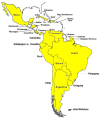Lyme Disease: A Review with Emphasis on Latin America
- PMID: 38399789
- PMCID: PMC10892289
- DOI: 10.3390/microorganisms12020385
Lyme Disease: A Review with Emphasis on Latin America
Abstract
The spirochete Borrelia burgdorferi sensu lato (Lyme Group) is the causative agent of Lyme disease, transmitted to humans through tick bites carrying the bacteria. Common symptoms include fever, headache, fatigue, and the characteristic erythema migrans skin rash. If left untreated, the infection can affect joints, the cardiac system, and the nervous system. Diagnosis relies on symptoms, clinical signs (such as the rash), and potential exposure to infected ticks, with laboratory tests proving valuable when appropriately employed with validated methods. Most cases of Lyme disease respond effectively to a few weeks of antibiotic treatment. In Latin America, knowledge of Lyme disease is limited and often confounded, underscoring the significance of this review in aiding medical professionals in recognizing the disease. This study delves explicitly into Lyme disease in Argentina, neighboring countries, and other Latin American nations.
Keywords: Borrelia burgdorferi; Latin America; Lyme disease.
Conflict of interest statement
The authors declare no conflict of interests.
Figures
References
-
- Centers for Diseases Control and Preventions Lyme Disease. [(accessed on 10 December 2023)]; Available online: https://www.cdc.gov/lyme/
-
- Cicutín G. ¿Lyme en Argentina? Síntesis de Noticias Veterinarias. Consejo Profesional de Médicos Veterinarios; Buenos Aires, Argentina: 2021. pp. 28–31.
-
- Rodríguez González I. Actualización acerca de Borrelia burgdorferi sensu lato y enfermedad de Lyme. [(accessed on 10 December 2023)];Revista Cubana de Medicina Tropical. 2013 65:149–165. Available online: http://scielo.sld.cu.
-
- Herrera Orestes L., Ferrer J.I., Ramírez Reyes C., Lavastida Hernández H. Enfermedad de Lyme: Historia, microbiología, epizootiología y epidemiología. Revista Cubana de Higiene y Epidemiología. 2011;50:231–244.
Publication types
Grants and funding
LinkOut - more resources
Full Text Sources


